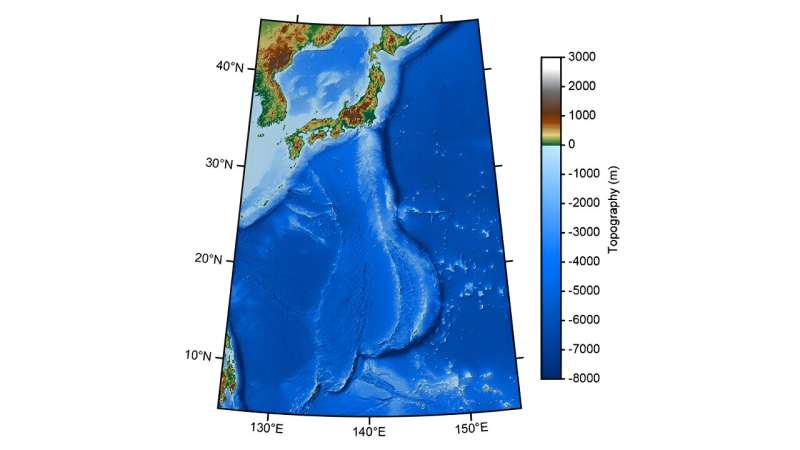The nature of mantle flow may depend on the type of slab subducting
At subduction zones, slabs of lithosphere sink into Earth’s mantle. Understanding how these slabs fit into mantle convection cells is important because of the role these movements play in plate tectonics. It’s also difficult, because processes deep beneath Earth’s surface cannot be directly measured.
In a new study published in Geochemistry, Geophysics, Geosystems, Samuel L. Goldberg and Adam F. Holt placed representations of Earth’s lithosphere and slabs into global models of mantle flow. This allowed the researchers to examine how slab subduction and mantle flow interact, both globally and at the regional scale around specific subduction zones.
They found that slab geometry can greatly influence the pressure and behavior of mantle convection. For instance, subduction zones with wide, long, and thick slabs—like the Kuril-Japan-Izu-Bonin-Mariana—are the primary forces behind mantle flow in their regions, acting mostly independently of other mantle structures. This finding agrees with other simple, regional modeling approaches.
But in other subduction zones, such as Sumatra, flow patterns can be influenced by other slabs or by larger-scale mantle flow, making them more muddled and complex. In particular, the phenomenon of dislocation creep, a type of deformation faster than that within most of the surrounding mantle, can cause the upper mantle flow to become decoupled from slab movement.
The researchers note that their findings show the complexities in subduction zones and mantle flow patterns around the globe. This also means that some canonical views of subduction-induced flows may need updating.
More information:
Samuel L. Goldberg et al, Characterizing the Complexity of Subduction Zone Flow With an Ensemble of Multiscale Global Convection Models, Geochemistry, Geophysics, Geosystems (2024). DOI: 10.1029/2023GC011134
This story is republished courtesy of Eos, hosted by the American Geophysical Union. Read the original story here.
Citation:
The nature of mantle flow may depend on the type of slab subducting (2024, February 26)
retrieved 26 February 2024
from https://phys.org/news/2024-02-nature-mantle-slab-subducting.html
This document is subject to copyright. Apart from any fair dealing for the purpose of private study or research, no
part may be reproduced without the written permission. The content is provided for information purposes only.

At subduction zones, slabs of lithosphere sink into Earth’s mantle. Understanding how these slabs fit into mantle convection cells is important because of the role these movements play in plate tectonics. It’s also difficult, because processes deep beneath Earth’s surface cannot be directly measured.
In a new study published in Geochemistry, Geophysics, Geosystems, Samuel L. Goldberg and Adam F. Holt placed representations of Earth’s lithosphere and slabs into global models of mantle flow. This allowed the researchers to examine how slab subduction and mantle flow interact, both globally and at the regional scale around specific subduction zones.
They found that slab geometry can greatly influence the pressure and behavior of mantle convection. For instance, subduction zones with wide, long, and thick slabs—like the Kuril-Japan-Izu-Bonin-Mariana—are the primary forces behind mantle flow in their regions, acting mostly independently of other mantle structures. This finding agrees with other simple, regional modeling approaches.
But in other subduction zones, such as Sumatra, flow patterns can be influenced by other slabs or by larger-scale mantle flow, making them more muddled and complex. In particular, the phenomenon of dislocation creep, a type of deformation faster than that within most of the surrounding mantle, can cause the upper mantle flow to become decoupled from slab movement.
The researchers note that their findings show the complexities in subduction zones and mantle flow patterns around the globe. This also means that some canonical views of subduction-induced flows may need updating.
More information:
Samuel L. Goldberg et al, Characterizing the Complexity of Subduction Zone Flow With an Ensemble of Multiscale Global Convection Models, Geochemistry, Geophysics, Geosystems (2024). DOI: 10.1029/2023GC011134
This story is republished courtesy of Eos, hosted by the American Geophysical Union. Read the original story here.
Citation:
The nature of mantle flow may depend on the type of slab subducting (2024, February 26)
retrieved 26 February 2024
from https://phys.org/news/2024-02-nature-mantle-slab-subducting.html
This document is subject to copyright. Apart from any fair dealing for the purpose of private study or research, no
part may be reproduced without the written permission. The content is provided for information purposes only.
